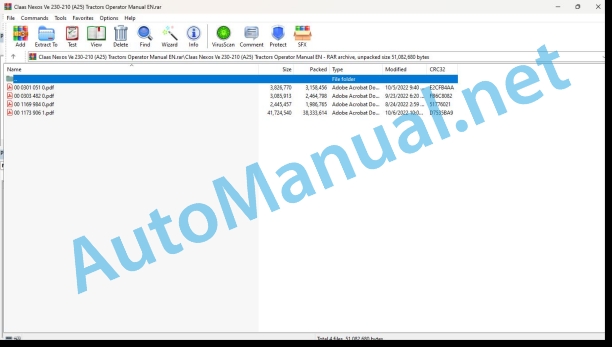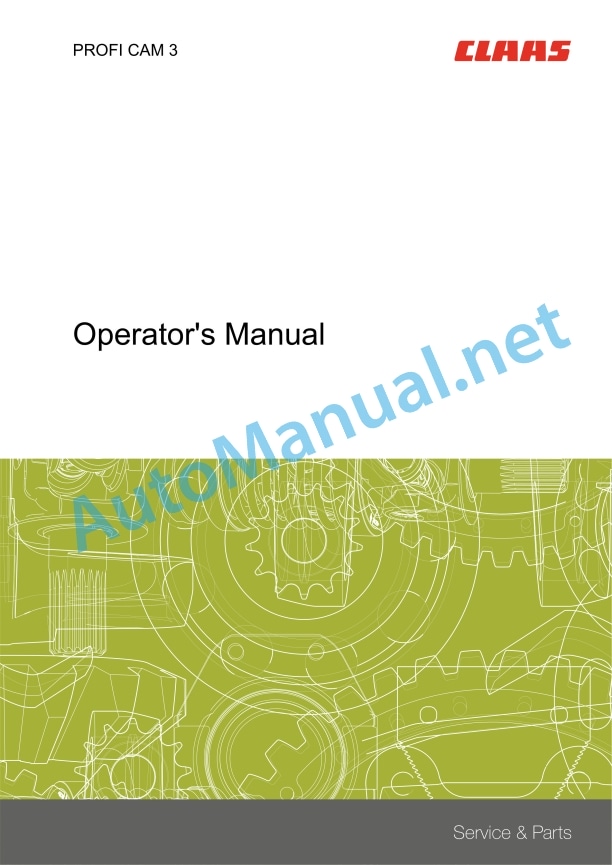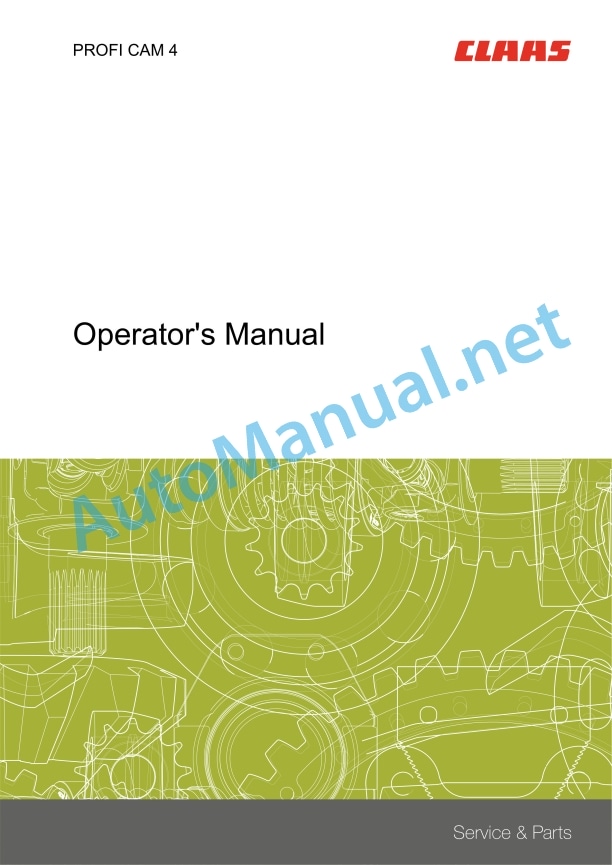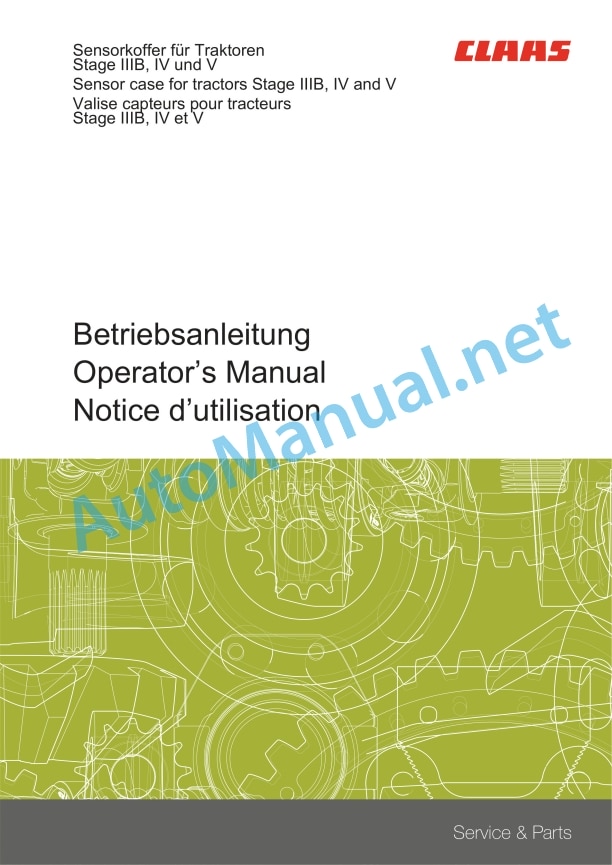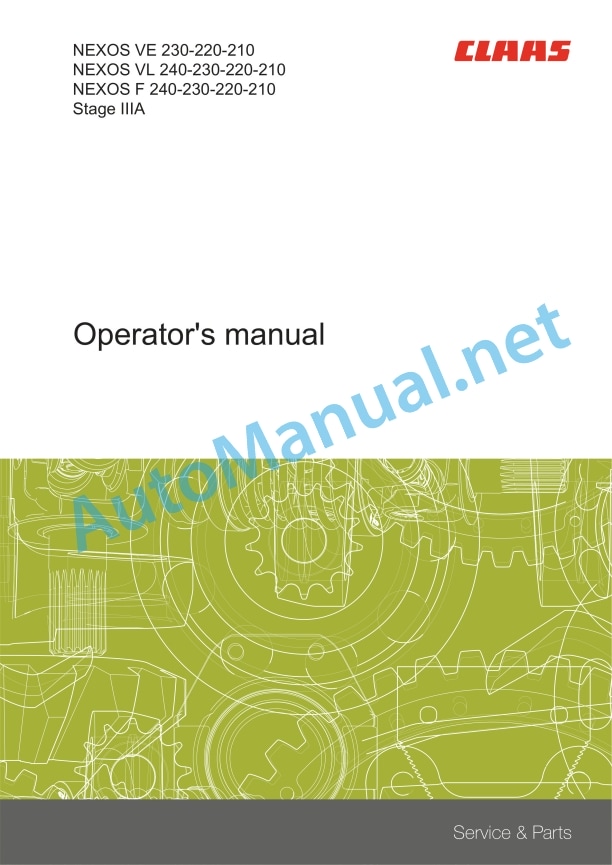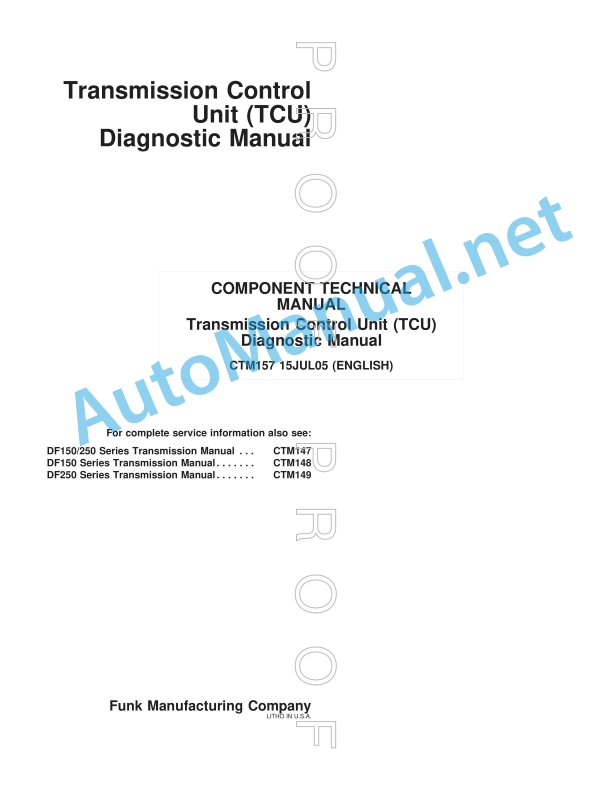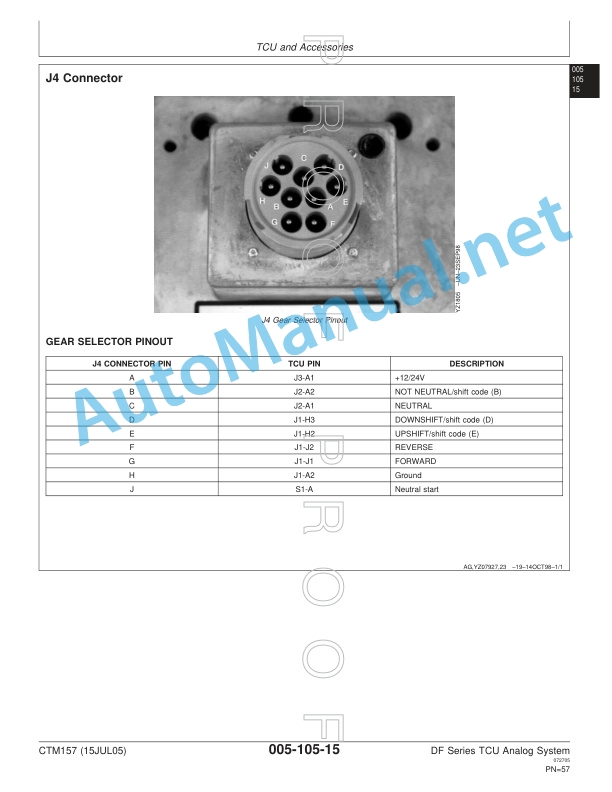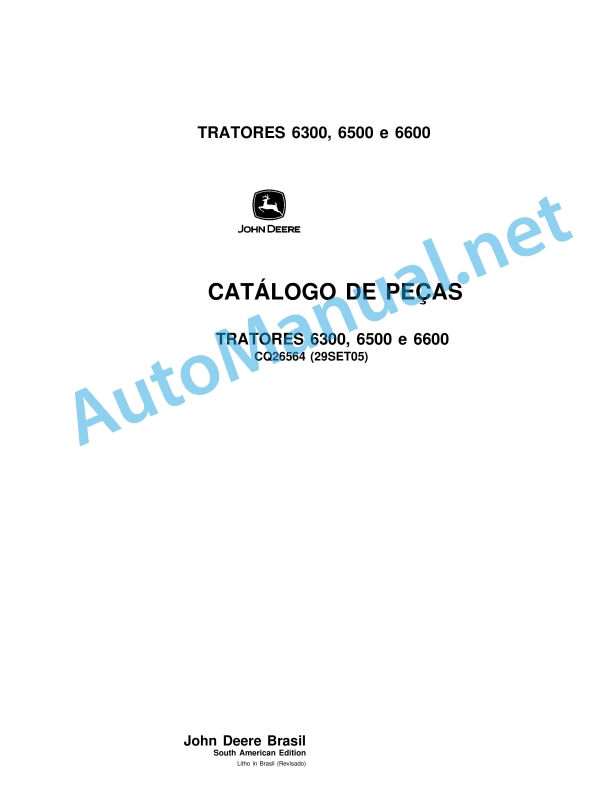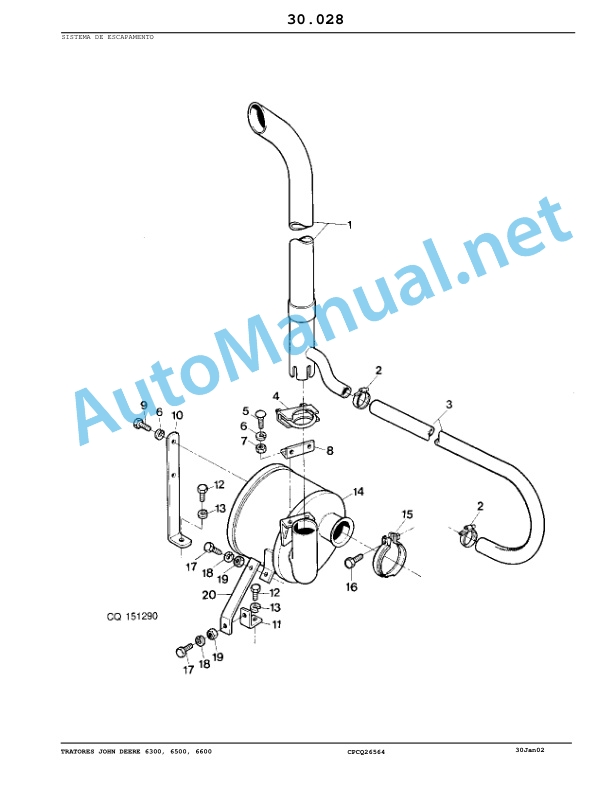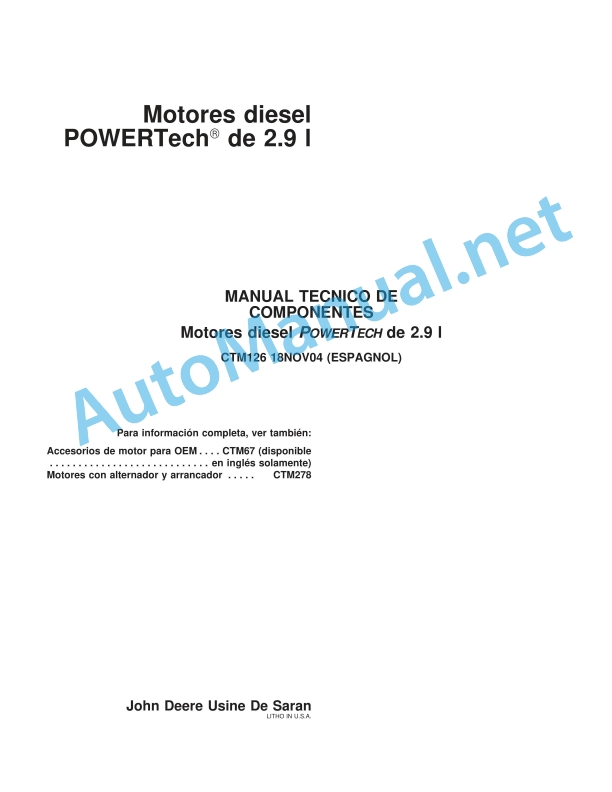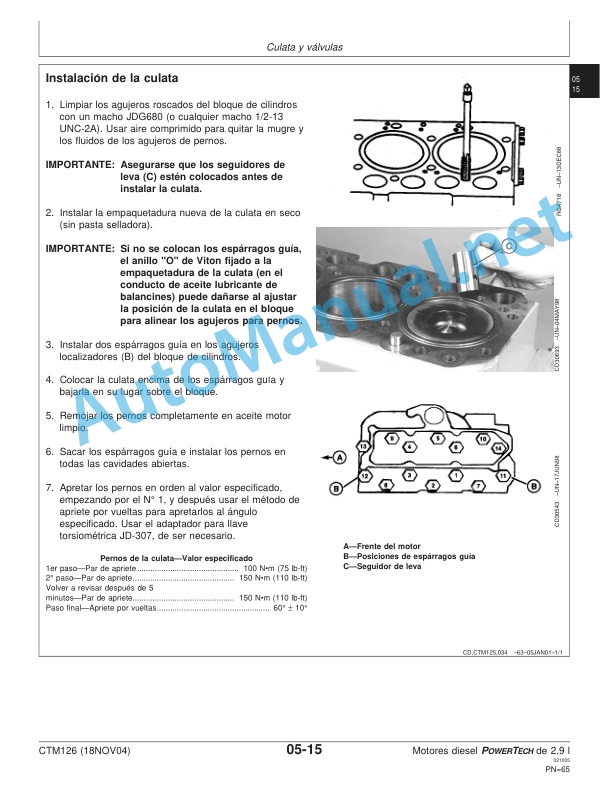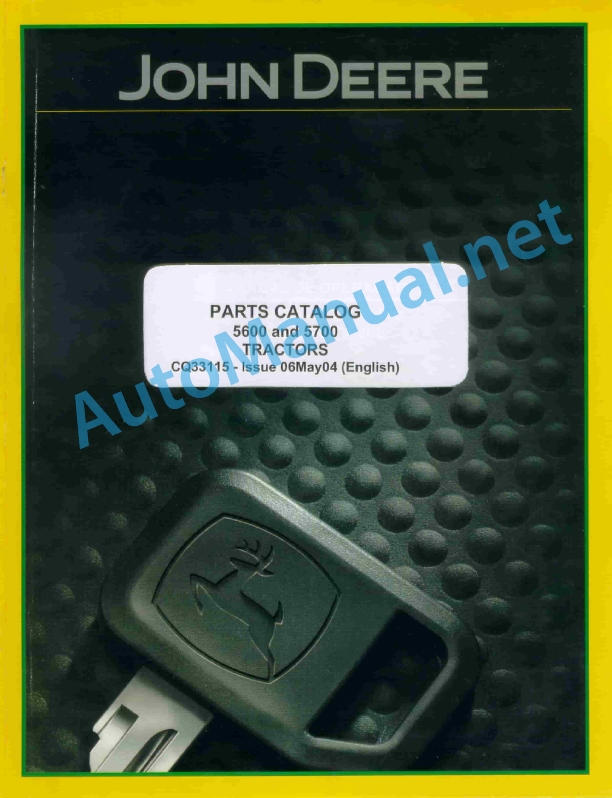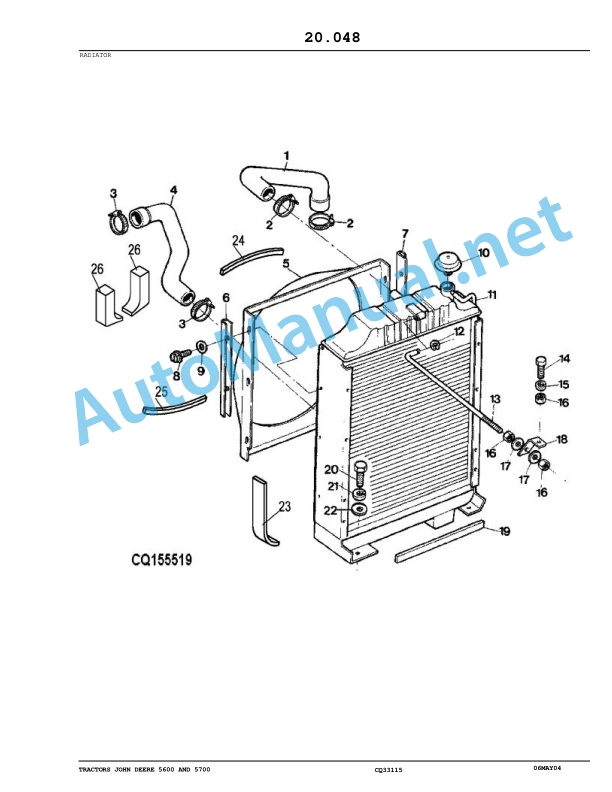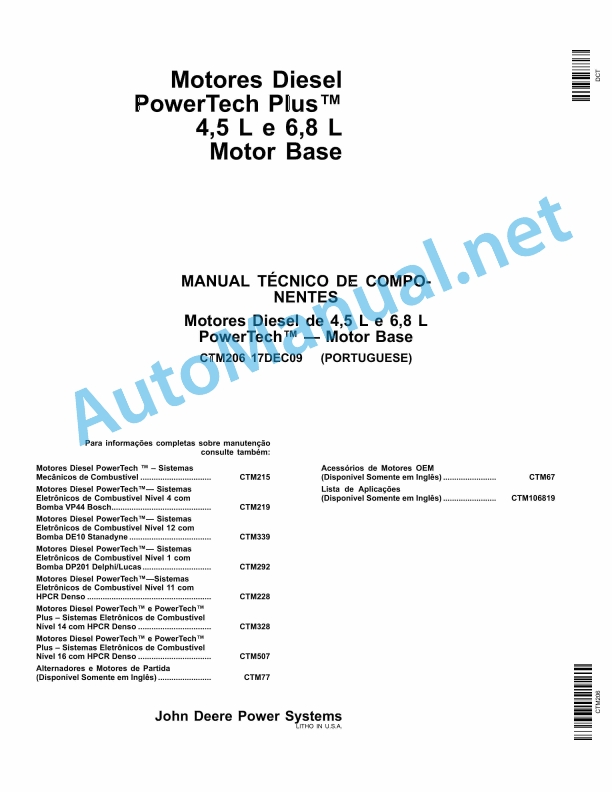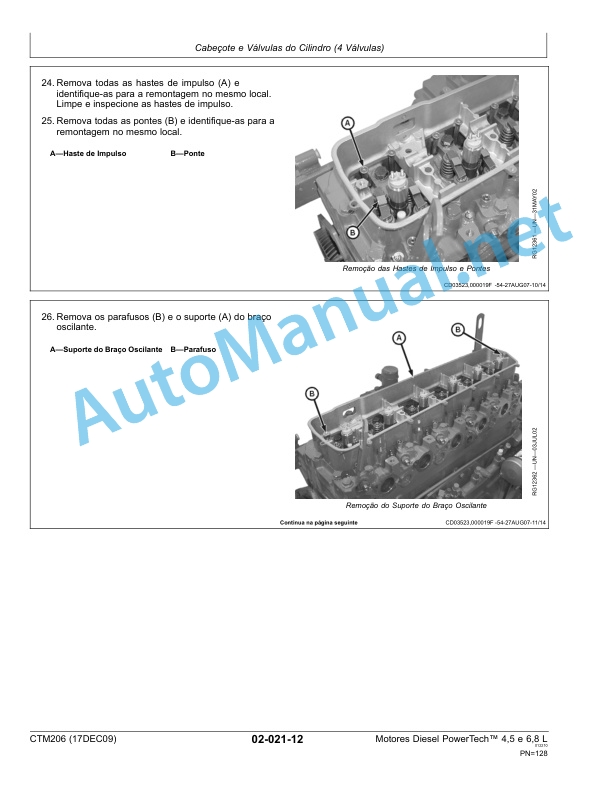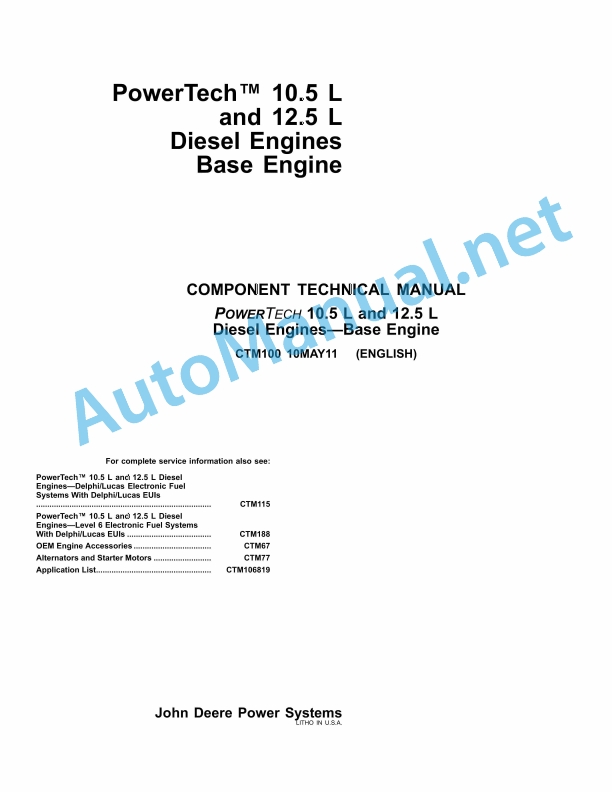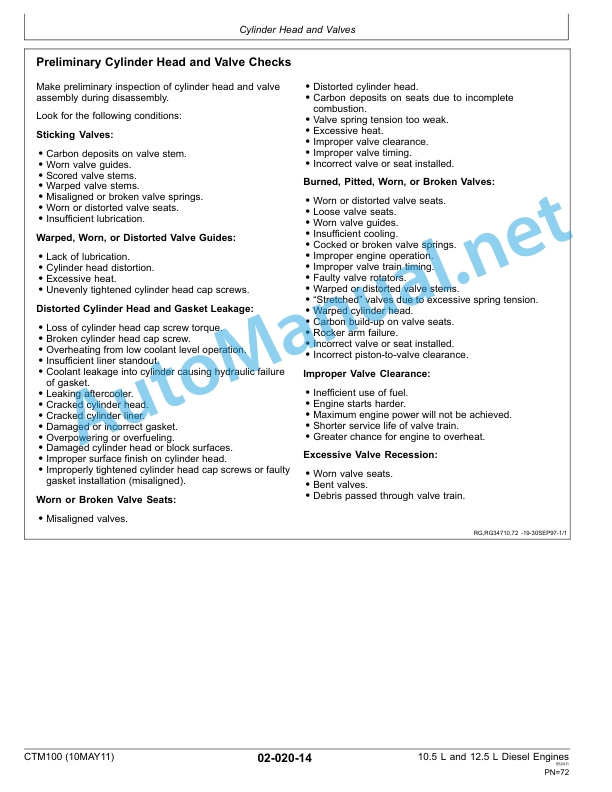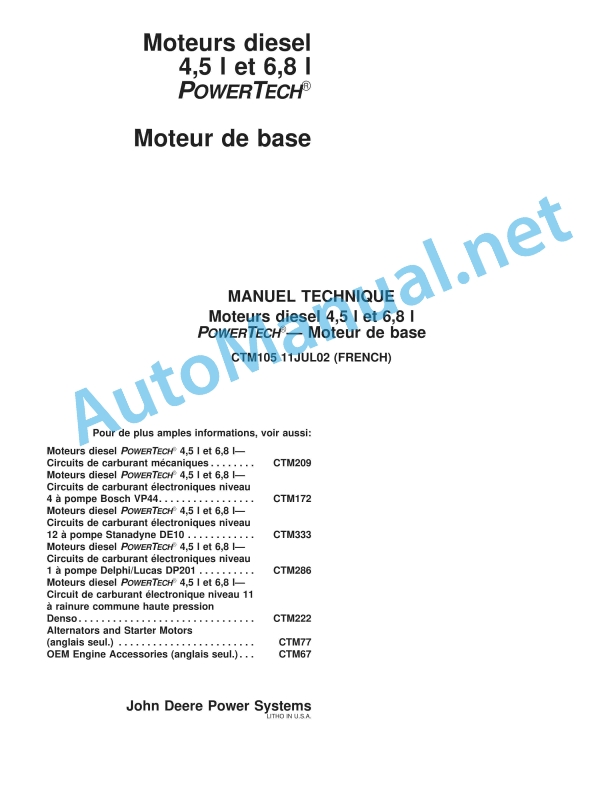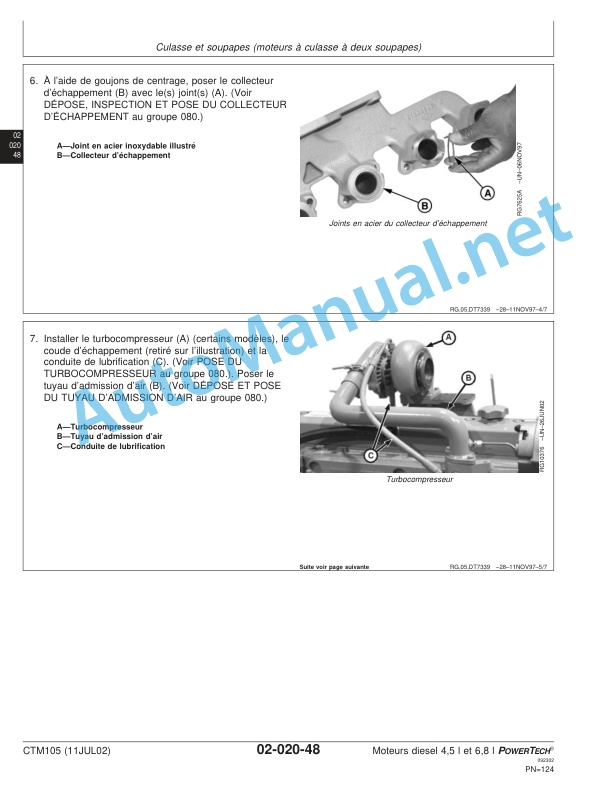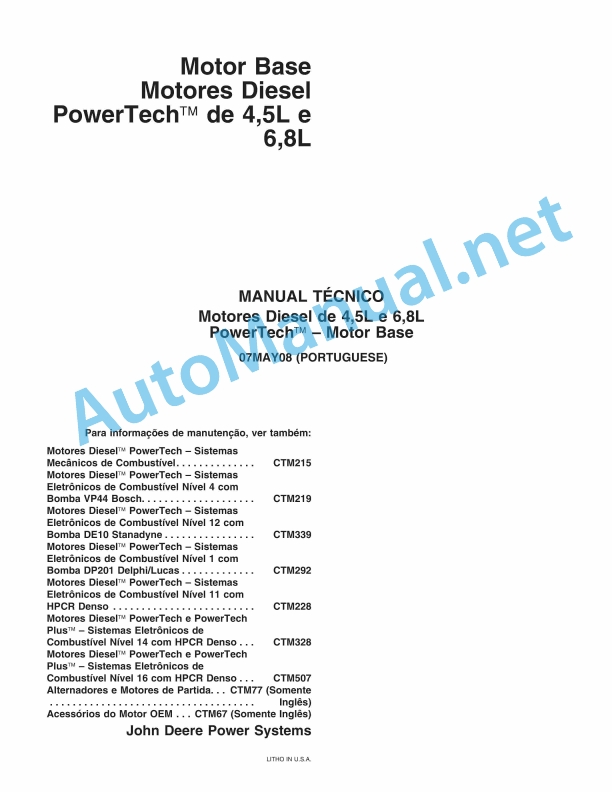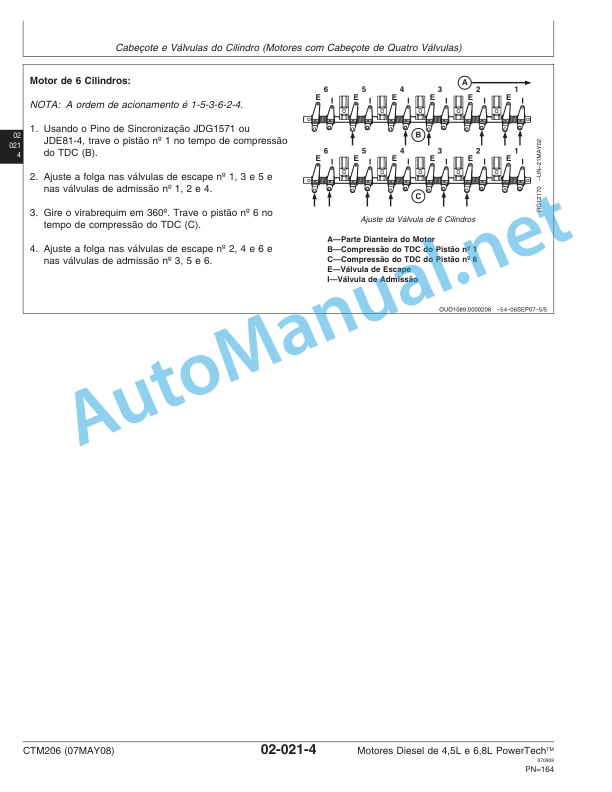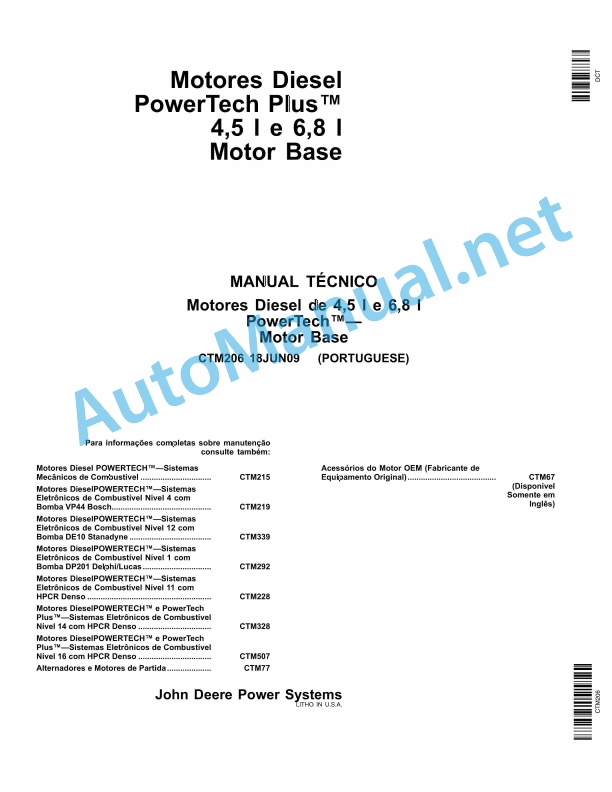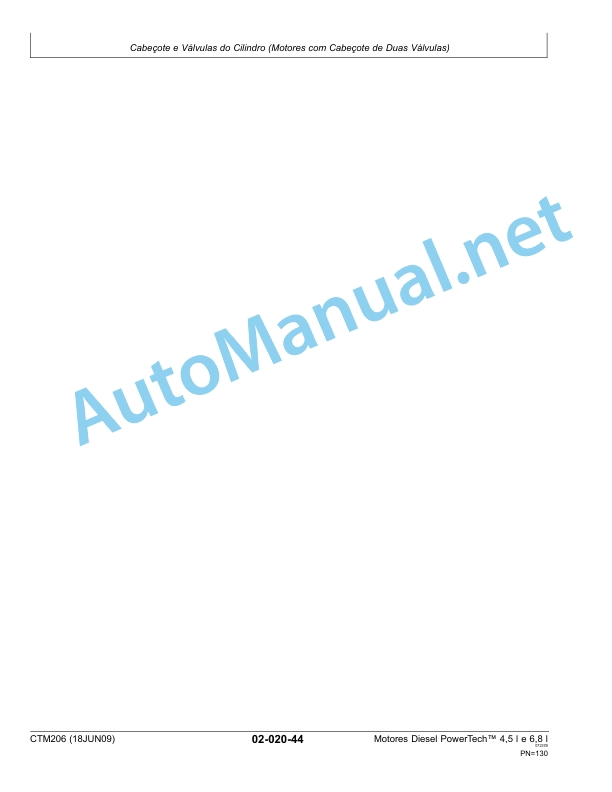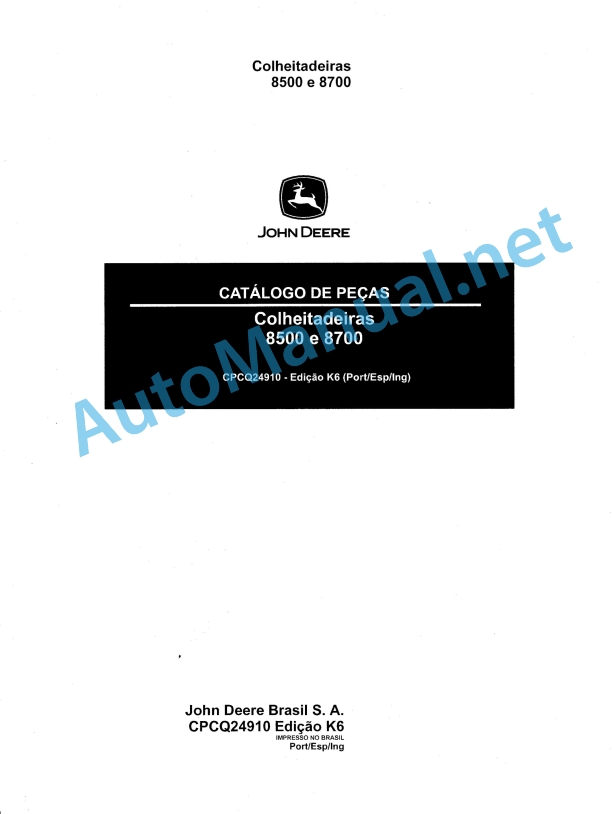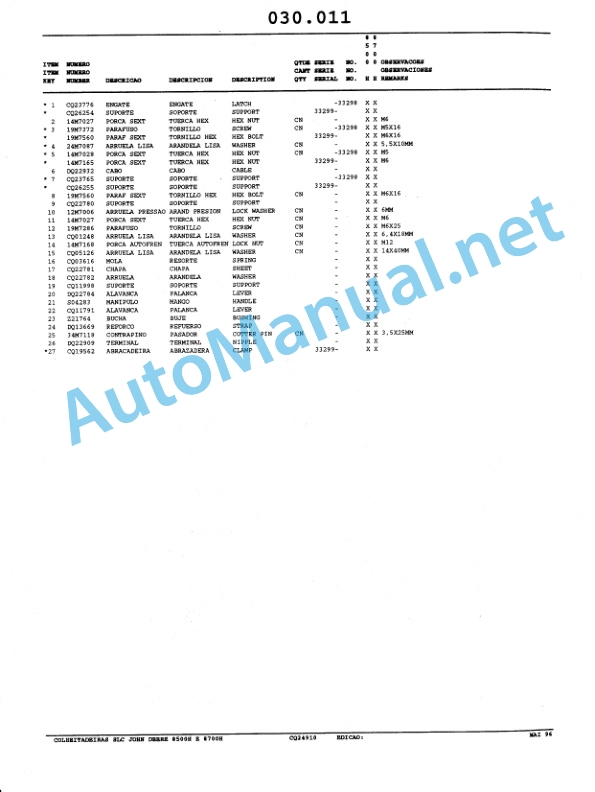Claas Nexos Ve 230-210 (A25) Tractors Operator Manual EN
$50.00
- Model: Nexos Ve 230-210 (A25) Tractors
- Type Of Manual: Operator Manual
- Language: EN
- Format: PDF(s)
- Size: 43.8 MB
File List:
00 0301 051 0.pdf
00 0303 482 0.pdf
00 1169 984 0.pdf
00 1173 906 1.pdf
00 0301 051 0.pdf:
PROFI CAM 3
Table of contents
1 Introduction
1.1 Notes on the manual
1.1.1 Validity of manual
1.1.2 Information about this Operator’s Manual
1.1.3 Symbols and notes
1.1.4 Optional equipment
1.1.5 Qualified specialist workshop
1.1.6 Maintenance information
1.1.7 Warranty notes
1.1.8 Spare parts and technical questions
1.2 Intended use
1.2.1 Intended use
1.2.2 Reasonably foreseeable misuse
2 Safety
2.1 Identifying warnings
2.1.1 Hazard signs
2.1.2 Signal word
2.2 Safety rules
2.2.1 Meaning of Operator’s Manual
2.2.2 Observing safety decals and warnings
2.2.3 Optional equipment and spare parts
3 Product description
3.1 Overview and method of operation
3.1.1 How the PROFI CAM works
3.2 Identification plates and identification number
3.2.1 Position of identification plates
3.2.2 Explanation of PROFI CAM identification plate
3.3 Information on the product
3.3.1 CE marking
4 Operating and control elements
4.1 Camera system
4.1.1 Camera system monitor
4.2 Menu structure
4.2.1 Main menu
4.2.2
4.2.3
4.2.4
4.2.5
4.2.6
5 Technical specifications
5.1 PROFI CAM
5.1.1 Monitor
5.1.2 Camera
5.1.3 Switch box
5.1.4 Degree of protection against foreign bodies and water
6 Preparing the product
6.1 Shutting down and securing the machine
6.1.1 Switching off and securing the machine
6.2 Prior to operation
6.2.1 Carry out prior to operation
6.2.2 Installing the sun protection
6.2.3 Aligning the camera
6.2.4 Connecting the camera electrics
7 Operation
7.1 Monitor
7.1.1 Switching on the monitor
7.1.2 Calling up the menu
7.1.3 Setting a menu item
7.1.4 Setting the image orientation
7.1.5 Setting automatic screen darkening
7.1.6 Image mirroring
7.1.7 Setting the trigger view
7.1.8 Setting the follow-up time for trigger view
7.1.9 Setting the display mode
7.1.10 Activating/deactivating a display mode
8 Faults and remedies
8.1 Electrical and electronic system
8.1.1 Overview of problems on PROFI CAM camera system
8.1.2 Replacing the switch box fuse
9 Maintenance
9.1 Maintenance intervals
9.1.1 Every 10 operating hours or daily
9.2 Camera system
9.2.1 Checking the camera system for dirt
9.2.2 Cleaning the camera
9.2.3 Cleaning the switch box
9.2.4 Cleaning the monitor
10 Placing out of operation and disposal
10.1 General Information
10.1.1 Putting out of operation and disposal
11 Technical terms and abbreviations
11.1 Abbreviations
11.1.1 Units
11.1.2 Abbreviations
11.1.3 Technical terms
00 0303 482 0.pdf:
PROFI CAM 4
Table of contents
1 Introduction
1.1 Notes on the manual
1.1.1 Validity of manual
1.1.2 Information about this Operator’s Manual
1.1.3 Symbols and notes
1.1.4 Optional equipment
1.1.5 Qualified specialist workshop
1.1.6 Maintenance information
1.1.7 Notes on warranty
1.1.8 Spare parts and technical questions
1.2 Intended use
1.2.1 Intended use
1.2.2 Reasonably foreseeable misuse
2 Safety
2.1 Identifying warnings
2.1.1 Hazard signs
2.1.2 Signal word
2.2 Safety rules
2.2.1 Meaning of Operator’s Manual
2.2.2 Structural changes
2.2.3 Optional equipment and spare parts
2.2.4 Operation only following proper putting into operation
2.2.5 Technical status
2.2.6 Respecting technical limit values
Respecting technical limit values
2.2.7 Hazards when driving on roads and fields
3 Product description
3.1 Overview and method of operation
3.1.1 How the PROFI CAM works
3.2 Identification plates and identification number
3.2.1 Identification plates
3.3 Information on the product
3.3.1 CE marking
4 Operating and display elements
4.1 Camera system
4.1.1 Camera system monitor
4.1.2 CEBIS
4.2 Menu structure
4.2.1 Main menu
4.2.2
4.2.3
4.2.4
4.2.5
4.2.6
5 Technical specifications
5.1 PROFI CAM
5.1.1 Monitor
5.1.2 Camera
5.1.3 Switch box
6 Preparing the product
6.1 Switching off and securing the machine
6.1.1 Switching off and securing the machine
6.2 Prior to putting into operation
6.2.1 Carry out prior to operation
6.2.2 Installing the sun protection
6.2.3 Aligning the camera
7 Operation
7.1 Monitor
7.1.1 Switching on the monitor
7.1.2 Calling up the menu
7.1.3 Setting a menu item
7.1.4 Setting the image orientation
7.1.5 Setting automatic screen darkening
7.1.6 Image mirroring
7.1.7 Setting the trigger view
7.1.8 Setting the follow-up time for trigger view
7.1.9 Setting the display mode
7.1.10 Activating/deactivating a display mode
8 Faults and remedies
8.1 Electric and electronic system
8.1.1 Overview of problems on PROFI CAM camera system
9 Maintenance
9.1 Maintenance intervals
9.1.1 Every 10 operating hours or daily
9.2 Camera system
9.2.1 Checking the camera system for dirt
9.2.2 Cleaning the camera
9.2.3 Cleaning the switch box
9.2.4 Cleaning the monitor
10 Putting out of operation and disposal
10.1 General information
10.1.1 Putting out of operation and disposal
11 Technical terms and abbreviations
11.1 Abbreviations
11.1.1 Units
11.1.2 Abbreviations
11.1.3 Technical terms
00 1169 984 0.pdf:
Sensor case for tractors Stage IIIB, IV and VSensor case for tractors Stage IIIB, IV and VSensor case for Stage IIIB, IV and V tractors
Contents
1 Sensorkoffer – Sensor case – Sensor suitcase – Stage IIIB, IV & V
1.1 Auflistung Kofferinhalt
1.1 Listing case content
1.1 Presentation of the contents of the suitcase
00 1173 906 1.pdf:
NEXOS VE 230-220-210NEXOS VL 240-230-220-210NEXOS F 240-230-220-210Stage IIIA
Table of contents
1 Introduction
1.1 Notes on the manual
1.1.1 Using the operator’s manual
Important information concerning this operator’s manual
Structure based on tractor sub-assemblies
Search and find
Direction indications
Specific terminology
Optional and additional equipment
1.1.2 Symbols and instructions
Text and illustrations
Highlighting dangers and warnings
1.1.3 Validity of the operator’s manual
1.1.4 Technical information
1.1.5 Spare parts and technical questions
2 Safety
2.1 Safety rules
2.1.1 Appropriate use
2.1.2 Inappropriate use
2.1.3 European regulation
2.1.4 Safety and accident prevention instructions
2.1.5 Driving the tractor
2.1.6 Checking the condition of the tractor
2.1.7 Climbing into and out of the tractor
Climbing into the tractor
Climbing out of the tractor
2.1.8 Cab
Safety structure of the cab
Polluted environment
2.1.9 Precautions to be taken before starting up
2.1.10 Hitching implements
2.1.11 Adjustments and maintenance work
Special notes on mounting the tractor on axle stands
2.1.12 Using the front and rear power take-off
2.1.13 Fuel
2.1.14 Engine coolant
2.1.15 Air conditioning
2.1.16 Electrical system
2.1.17 Applications with front loaders
2.1.18 Forest applications
2.1.19 Stationary working
2.2 Safety decals on the tractor
2.2.1 General advice regarding the safety markings
2.2.2 Warning symbols
2.3 Safety devices
2.3.1 Wheel chock
3 Tractor description
3.1 Overview
3.1.1 Front left-hand view
3.1.2 Rear left-hand view
3.2 Identification plates and vehicle identification number
3.2.1 Tractor identification plate
Tractor identification number
Tractor regulation type
Tractor serial number
3.2.2 Tractor power label
3.2.3 Engine identification plate
3.2.4 Transmission identification plate
3.2.5 Front axle identification plate
Four-wheel drive tractor with a rigid front axle
Four-wheel drive tractor with a suspended front axle
Tractor with two-wheel drive
3.2.6 Cab identification plate
4 Operating and display elements
4.1.1 Driving position
Right-hand controls
Left-hand controls
4.1.2 Dashboard
Tractors with clutchless reverser
Tractors with mechanical inverter
4.1.3 Rear mechanical linkage controls
4.1.4 TCE 6 electronic linkage controls
4.1.5 Instrument panel
4.1.6 Digital display
4.1.7 Key operated ignition
4.1.8 Heating, ventilation and air conditioning controls
4.1.9 Control lever for indicator lights and horn
4.1.10 Work light controls
Cab version
Version with platform
4.1.11 Switch box electrical socket
4.2 Hydraulic system
4.2.1 Hydraulic controls
Front linkage
Converting single/double action auxiliary hydraulic control valves
4.3 Electric and electronic system
4.3.1 External controls
Mechanical rear linkage
TCE 6 electronic rear linkage
4.4 Assembled parts/Machine housing
4.4.1 Toolbox
5 Technical specifications
5.1 NEXOS
5.1.1 Dimensions
Cab version
Version with platform
5.1.2 Weight
Four-wheel drive cab version
Two-wheel drive cab version
Four-wheel drive version with platform
Two-wheel drive version with platform
5.1.3 Engine
5.1.4 Transmission
Mechanical transmission
Electrohydraulic transmission
5.1.5 Ground speeds
5.1.6 Without doubler and 12/12 transmission – 30 km/h version
5.1.7 Mechanical doubler and 24/24 transmission 40 km/h version
5.1.8 Electrohydraulic doubler
24/24 transmission – 30 km/h version
24/12 transmission – 40 km/h version
.9 Front axle (two-wheel drive)
5.1.10 Front drive axle (four-wheel drive)
Front/Rear inter-axle ratio
NEXOS VE synchro ratios
NEXOS VL synchro ra NEXOS F synchro ratios
5.1.11 Rear axle
5.1.12 Brakes
5.1.13 Steering
5.1.14 Rear linkage
5.1.15 Front linkage
5.1.16 Rear hitches
5.1.17 Rear power take-off
5.1.18 Front power take-off
5.1.19 Hydraulic circuits
Centre open circuit 59 l/min
Open centre circuit 85 l/min
5.1.20 Auxiliary hydraulic control valve combinations
Auxiliary hydraulic control valves
Auxiliary electrohydraulic control valves
5.1.21 Electrical circuit
5.1.22 Sound level
Sound level heard by the driver (according to European Directive 2009/76)
Sound level heard by a passer-by (according to European Directive 2009/63 Annex VI)
5.1.23 Seat vibration level
5.1.24 Ballast
Compatibility of ballast with tyres
NEXOS VE
NEXOS VL
5.1.25 Maximum authorised tow weights
Two-wheel drive version
Four-wheel drive version
5.1.26 Load capacities
5.2 Operating utilities
5.2.1 Lubricants/Hydraulic oil
5.2.2 Engine coolant
5.2.3 Brake fluid
5.2.4 Air conditioning circuit
6 Tractor preparation
6.1 Engine
6.1.1 Fuel
Quality requirement
Special notes on biofuels
Fuel lubricity
Handling fuel
6.1.2 Topping up the fuel
6.2 Frame
6.2.1 NEXOS 230-210 VE: Table of front track widths
Front axle (Four-wheel drive version)
Front axle (Two-wheel drive version)
6.2.2 NEXOS 230-210 VE: Table of rear tracks
6.2.3 NEXOS 240-210 VL: Table of front track widths
Front axle (Four-wheel drive version)
Front axle (Two-wheel drive version)
6.2.4 NEXOS 240-210 VL: Table of rear tracks
6.2.5 NEXOS 240-210 F: Table of front track widths
Front axle (Four-wheel drive version)
Front axle (Two-wheel drive version)
6.2.6 NEXOS 240-210 F: Table of rear tracks
6.2.7 Tyre combinations
6.2.8 Adjusting the rear axle track
Tracking method
6.2.9 Adjusting the steering stops
Adjustment
6.2.10 General information about the tyres
6.2.11 Inflation pressure
Effect on soil compaction
Effect on consumption
6.2.12 Specifications
Load index
Speed symbol
6.3 Brake
6.3.1 Coupling the brake pedals
6.3.2 Trailer hydraulic brake
6.4 Steering
6.4.1 Steering column
6.5 Rear power lift
6.5.1 Axle stands
6.5.2 Top link
6.5.3 Stabilisers
NEXOS VE – VL
6.5.4 Vertical hydraulic tie-rod
6.5.5 Automatic hitches
6.5.6 Rear linkage external controls
Mechanical linkage
Hydraulic linkage
6.5.7 Hitching/unhitching an implement
Hitching recommendations
Hitching
Unhitching
6.6 Front power lift
6.6.1 Converting the single action/double action front linkage
6.6.2 Locking the front linkage
6.6.3 Top link
6.6.4 Lower links for the front linkage
6.6.5 Automatic hitches
6.6.6 Hitching/unhitching an implement
Hitching recommendations
Hitching
Unhitching
6.7 Rear power take-off
6.7.1 Hitching and unhitching an implement
Connecting and disconnecting the rear power take-off universal drive shaft
Hitching
Unhitching
6.7.2 Hitching implements to the power take-off
6.8 Hitch
6.8.1 Recommendations
6.8.2 Calculating the maximum tow load (not including CUNA clevis)
6.8.3 Clevis drawbars
6.8.4 Swinging drawbar
Tightening the clevis
Safety device
6.8.5 Pick-up hitch
6.9 Rear hydraulic system
6.9.1 Rear pressure connectors
Connecting/Disconnecting the pressure connectors
Free return to the tank
Mechanically-controlled auxiliary hydraulic control valves
Auxiliary electrohydraulic control valves
6.9.2 Single/double action setting
6.10 Electric and electronic system
6.10.1 Electrical sockets
Trailer/implement lighting socket
Switch box electrical socket
6.10.2 Adjustment of dipped lights
6.11 Cab and operator’s platform
6.11.1 Adjusting the rear-view mirrors
6.11.2 Folding roll hoop
6.11.3 Platform version indicators
6.11.4 Adjusting the comfort driver’s seat – Cab version
6.11.5 Adjusting the pneumatic driver’s seat – Cab version
6.11.6 Adjusting the driver’s seat (waterproof seat) – Platform version
6.11.7 Cable routing
6.11.8 Storage
6.12 Assembly parts and machine body
6.12.1 Ballast
6.12.2 Balancing the tractor with mounted implements
Summary table
6.12.3 Fitting and removing the front weights
6.12.4 Opening and closing covers
One-piece bonnet
Opening the engine bonnet
Closing the engine bonnet
Side covers
Removing the side panels
Refitting the side panels
6.13 Transport of the tractor
6.13.1 Transport
7 Operation
7.1 Engine
7.1.1 Running in
7.1.2 Starting the engi Preliminary operations
Mechanical version
Electrohydraulic engagement
Start up
Recommendations
7.1.3 Accelerator pedal
7.1.4 Hand accele 7.1.5 Switching off the engine
7.2 Transmission, clutch and driveshaft
7.2.1 Shifting the reverser into neutral
Tractors with mechanical inverter
Tractors with clutchless reverser
7.2.2 Selecting the tractor’s travel direction
Recommendations
Mechanical reverser
Clutchless reverser
7.2.3 Clutch
Clutch pedal
Switch (tractors with clutchless reverser)
7.2.4 Speed selection
7.2.5 Range selection
7.2.6 Range doubler
Mechanical range doubler
Electrohydraulic range doubler
7.2.7 Differential lock
7.3 Chassis
7.3.1 Front axle engagement
General points
Automatic mode
Operation
Permanent mode
Operation
7.4 Brake
7.4.1 Service brakes
7.4.2 Handbrake (auxiliary and parking brake)
7.5 Mechanical rear linkage
7.5.1 Position control
7.5.2 Draft control
7.5.3 Mixed control
7.5.4 Floating linkage
7.5.5 Sensitivity adjustment
7.5.6 External controls
7.6 Electronic rear linkage
7.6.1 Warning light
7.6.2 Road transport safety
7.6.3 Operating the linkage
7.6.4 Selecting modes
7.6.5 Position control
7.6.6 Draft control
7.6.7 Upper stop
7.6.8 Lowering speed
7.6.9 Rapid soil entry function
7.6.10 Electrohydraulic rear linkage external controls
7.7 Front power lift
7.7.1 Using the front linkage
Mechanically-controlled hydraulic control valve
Electrohydraulic control valve
7.8 Rear power take-off
7.8.1 Selecting the rear power take-off speed
Selecting the drive-proportional power take-off speed
7.8.2 Use
Power take-off with assisted mechanical engagement
Electrohydraulic actuation power take-off
7.8.3 Stationary working
7.9 Front power take-off
7.9.1 Using the front power take-off
Front power take-off engagement
7.10 Rear hydraulic system
7.10.1 Rear pressure connectors and controls
Mechanically-controlled auxiliary hydraulic control valves
Auxiliary electrohydraulic control valves
7.10.2 Mechanically-controlled auxiliary hydraulic control valves
7.10.3 Auxiliary electrohydraulic control valves
Controls
Start up
Linear controls
Pressure position
Floating position
Hydraulic timer
Joystick
Floating position
Other functions
7.10.4 Hydraulic timer
7.10.5 Setting the flow rates
Mechanically-controlled auxiliary hydraulic control valves
Auxiliary electrohydraulic control valves
7.10.6 Stationary working
7.11 Cab and operator’s platform
7.11.1 Instrument panel display
7.11.2 Manual air conditioning
7.11.3 Overhead light
7.11.4 Windscreen washer and wiper controls
Steering column controls
Cab top controls
7.11.5 Hinged panels and windows
Hinged panels
Left and right doors
Opening tailgate
Windscreen open
Sun blind
7.11.6 Sight
8 Faults and remedies
8.1 Alarms
8.1.1 Primary alarms
8.1.2 Secondary alarms
8.1.3 Other alarms
8.2 Engine
8.2.1 Faults caused by a low fuel level
8.3 Frame
8.3.1 Fitting a jack
8.3.2 Replacing a wheel
8.3.3 Towing the tractor
Towing with the engine running
Towing with the engine stopped
8.3.4 Digging out the tractor
Digging out a tractor
Digging out a tractor by towing
8.4 Electric and electronic system
8.4.1 Fuses and relays
Main fuse box
Right-hand post fuse box
Left-hand post fuses and relays
Fuse box under the dashboard
Engine compartment fuse box
Preheating fuse/relay
Fuse and relays – electronic linkage
Main cab fuse
Auxiliary electrohydraulic control valve fuses and relays
8.4.2 Configuring the instrument panel
Procedure
Selecting the speed code
Speed parameters table
Selecting the measurement unit
Selecting the rear power take-off speed
Selecting the front power take-off
Selecting the axle type
8.4.3 Overview of the lights
9 Maintenance
9.1 Maintenance Information
9.1.1 Personal protective equipment
9.1.2 Switching off the engine and securing the tractor
9.1.3 Cleaning and tidying risk areas
9.1.4 Welding advice
9.1.5 Protective devices on the tractor
9.1.6 Engine
Alternator
Engine lubrication
Engine cooling
Engine belts
9.1.7 Wheels and tyres
9.1.8 Braking system
9.1.9 Direction
9.1.10 Implements driven by a power take-off
9.1.11 Air conditioning
9.1.12 Hydraulic circuit
9.1.13 Electrical system
9.1.14 Energy accumulators
9.1.15 Spare parts
9.1.16 Greasing
9.1.17 Cleaning and protection
9.1.18 Working at height
9.1.19 Handling heavy components
9.1.20 Maintenance operations under the cab or the platform
9.1.21 Lifting the front of the tractor
9.2 Maintenance interval overview
9.2.1 After the first 10 hours of operation
9.2.2 After the first 40 hours of operation
9.2.3 After first 100 hours
9.2.4 After the first 500 hours or between the eighth and tenth months
9.2.5 Every 10 hours
9.2.6 Every 50 hours
9.2.7 Every 50 hours or every week
9.2.8 Every 100 hours
9.2.9 Every 250 hours
9.2.10 Every 400 hours of operation
9.2.11 Every 500 hours
9.2.12 Every 500 hours or every 6 months
9.2.13 Every 500 hours of operation or every year
9.2.14 Every 1000 hours
9.2.15 Every 1000 hours or every 2 years
9.2.16 Every 1500 hours
9.2.17 Every 1500 hours or every 2 years
9.2.18 Every 1800 hours
9.2.19 Every 2000 hours
9.2.20 Every 3000 hours
9.2.21 Every 4500 hours
9.3 Lubrication plan
9.3.1 Greasing points – 50 hrs
9.3.2 Greasing points – 100 hrs
9.3.3 Greasing points – 250 hrs
9.3.4 Greasing points – 500 hrs
9.3.5 Greasing points – 1000 hrs
9.4 Maintenance engine
9.4.1 Check the rocker arms – NEXOS VE VL F (230 220 210)
9.4.2 Check throcker arms – NEXOS VL F (240)
9.4.3 Changing the fuel filter
Water trap pre-filter (depending on the equipment)
Fuel filter
9.4.4 Check the injection circuit pipes and connections
9.4.5 Replace the fuel strainer
9.4.6 Eliminate water in the fuel
Water trap pre-filter (depending on the equipment)
Fuel filter
9.4.7 Cleaning the fuel strainer
9.4.8 Check the pressure rating of the injectors
9.4.9 Checking the injection pump – NEXOS VL F (240)
9.4.10 Bleeding air from the injection circuit
NEXOS VE – VL – F (230 – 220 – 210)
NEXOS VL – F (240)
9.4.11 Changing the engine oil
NEXOS VE, VL, F (230, 220, 210)
NEXOS VL, F (240)
9.4.12 Replace the engine oil filter cartridge
9.4.13 Check the engine oil level
9.4.14 Check the cooling c seal
9.4.15 Check the coolant level
9.4.16 Cleaning the coolers
9.4.17 Check the alternator belt and the engine coolant pump
NEXOS VE – VL – F (230 – 220 – 210)
S VL – F (240)
9.4.18 Replace the alternator belt and the engine coolant pump
NEXOS VE – VL – F (230 – 220 – 210)
NEXOS VL – F (240)
9.4.19 Changing the fluid in the engine cooling circuit and thermostat
9.4.20 Tighten manifolds
9.4.21 Checking the turbocharger – NEXOS VL F (240)
9.4.22 Clean the engine air filter
9.4.23 Replace the engine air filter
9.4.24 Check the air intake seal
9.4.25 Checking the preheating – NEXOS VL F (240)
9.4.26 Replacing the engine air filter safety cartridge
9.5 Maintenance operations gearbox
9.5.1 Adjust the clutch clearance (depending on equipment)
9.5.2 Check the Safety patch solenoid valve (tractor with clutchless reverser)
9.6 Maintanance operations chassis
9.6.1 Replace the front axle final drive oil
Tractor with d front axle
Tractor with suspended front axle
9.6.2 Replace the front axle differential unit oil
Tractor with rigid front axle
Tractor with suspended front axle
9.Check the front axle seal
9.6.4 Check the level of the front axle final drive oil
9.6.5 Check the oil level of the front axle differential casing
Tractor with rigid front axle
Tractor with suspended front axle
9.6.6 Check and adjust the wheel alignment
9.6.7 Changing the front axle breather
9.6.8 Check the tightness of the wheel discs on the hubs
9.6.9 Check the tightness of the wheel discs on the rims
9.6.10 Checking the condition of the wheels and tyres and checking the tyre inflation pressure
9.7 Maintenance operations brake
9.7.1 Check and adjust the service brakes
9.7.2 Check the service brake fluid level
9.7.3 Check that the brakes work properly
9.7.4 Check the service brake clearance
9.7.5 Change the braking circuit fluid
9.7.6 Replacing the braking circuit reservoir cap
9.7.7 Checking the handbrake clearance
9.8 Maintenance work on steering
9.8.1 Check the operation of the hydrostatic steering
9.9 Maintenance operations hitch
9.9.1 Check the clearance of the clevises
9.10 Rear power take-off maintenance operations
9.10.1 Checking the rear power take-off clutch clearance
9.10.2 Check the assisted mechanical power take-off clutch control
9.11 Maintenance front power take-off
9.11.1 Check the level of the front power take-off unit oil
9.11.2 Replacing the front power take-off unit oil
9.12 Maintenance operations hydraulic
9.12.1 Check the transmission/hydraulic oil level
9.12.2 Checking the belt on the third hydraulic pump – NEXOS VL F (240)
9.12.3 Replacing the belt on the third hydraulic pump – NEXOS VL F (240)
9.12.4 Replacing the hydraulic circuit/transmission filter cartridge
9.12.5 Replace the hydraulic strainer
9.12.6 Check the hydraulic circuit
9.12.7 Changing the hydraulicnsmission oil
9.13 Maintenance electrical / electronics
9.13.1 Check that the dry air filter clogging warning light is operating
9.13.2 Clean and grease the battery terminals
9.13.ecking the instrument panel operation
9.13.4 Checking the operation and condition of the lighting and signalling devices
9.14 Maintenance Cab / Operator’s platform
9.14.1 Check the screen washer fluid level
9.14.2 Check the operation of the heating, ventilation and air conditioning controls
9.14.3 Cleaning the cab air filter
9.14.4 Lubrication of the air conditioning compressor
9.14.5 Replace the cab air filter
9.14.6 Check the air conditioning compressor belt
9.14.7 Checking the air conditioning dehumidifier
9.14.8 Replace the air conditioning compressor belt
9.15 Maintenance operations machine body
9.15.1 Check the tightness of the connecting bolts
9.15.2 Clean the radiator grilles
9.16 Storage
9.16.1 Storage instructions
Long-term storage
Restarting the tractor
10 Putting out of operation and disposal
10.1 Information on the machine
10.1.1 Scrapping and waste disposal
11 Technical terms and abbreviations
11.1 Technical terms and abbreviations
11.1.1 Technical terms
11.1.2 Abbreviations
John Deere Repair Technical Manual PDF
John Deere Transmission Control Unit Component Technical Manual CTM157 15JUL05
John Deere Parts Catalog PDF
John Deere Tractors 6300, 6500, and 6600 Parts Catalog CQ26564 (29SET05) Portuguese
John Deere Repair Technical Manual PDF
John Deere Diesel Engines POWERTECH 2.9 L Component Technical Manual CTM126 Spanish
John Deere Repair Technical Manual PDF
John Deere Repair Technical Manual PDF
John Deere PowerTech M 10.5 L and 12.5 L Diesel Engines COMPONENT TECHNICAL MANUAL CTM100 10MAY11
John Deere Repair Technical Manual PDF
John Deere Repair Technical Manual PDF
John Deere Diesel Engines PowerTech 4.5L and 6.8L – Motor Base Technical Manual 07MAY08 Portuguese
John Deere Repair Technical Manual PDF
John Deere Parts Catalog PDF
John Deere Harvesters 8500 and 8700 Parts Catalog CPCQ24910 Spanish

